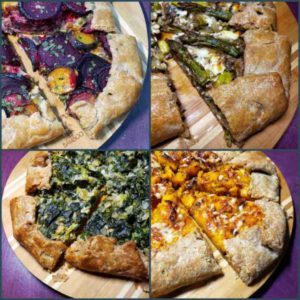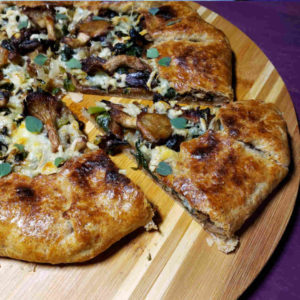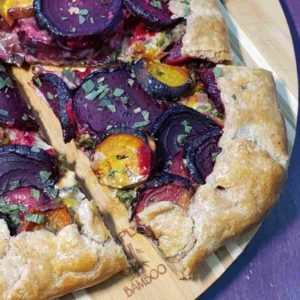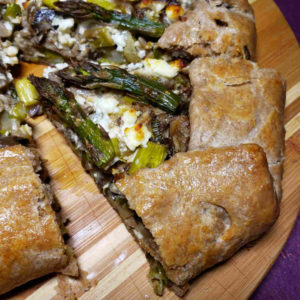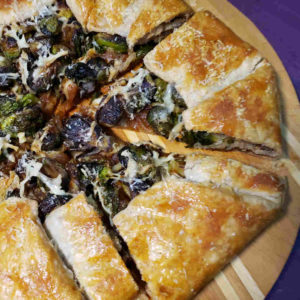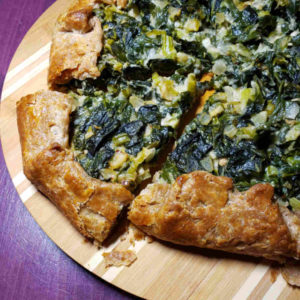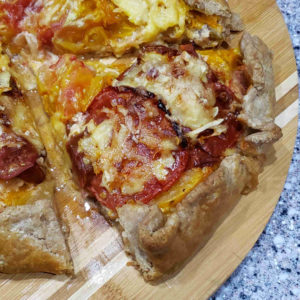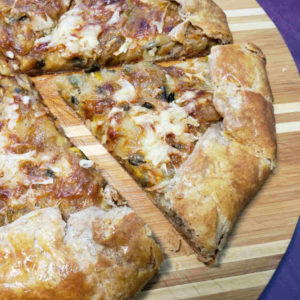Gallery
A gallery depicting several potential combinations of ingredients that can be used with this mother dish technique.
I consider the savory galette to be a mother dish, because the crust is simply a vessel for whatever goodness you want it to carry. Any season of the year, what’s fresh and local can become the stars of a savory galette. It offers less of a framework than most of my other mother dish techniques, so some extra creativity may be needed. The more experience you have with cooking in general, the more comfortable you will be with winging the fillings for a savory galette. Don’t let that intimidate you. I’ll post examples that you can use, with more on the way. In this post I’ll give general tips that you can use to devise your own.
Pie Dough
Of course, if you are going to make a pie of any type, you need a pie dough. I have a recipe for you, but if you have one that you are really happy with, stick with it. Anyway, the recipe I use is based on a super easy pie dough recipe, developed by J Kenji Lopez-Alt. That recipe is intended for sweet pies. To make it more appropriate for savory pies, I make 3 alterations. First I remove the sugar from the recipe. Second, instead of all-purpose flour, I use a 50/50 mix of all purpose and whole wheat flours. Third, I include the option of adding fresh or dried herbs or finely grated aged cheese to turn up the savory one more notch. The recipe is included below and discussed in more detail in my Easy Savory Pie Dough post.
Filling
Do you have a favorite casserole that you would like to move from side dish status to star dish status? If you can make a casserole with it, you can probably make a galette with it. That fact speaks to the versatility of the galette. There are endless options for casseroles. The galette offers just as many options.
Vegetables
Choose your favorite vegetable of the season to be the star. Or choose two or three to co-star. About two pounds worth of vegetables, give or take half a pound, is a good amount. You usually want to cook your galette vegetables, at least partially, before baking the galette. This is for at least a few reasons. Often the ingredients will require more time to cook than the final baking time for the crust. Ingredients which release a lot of water as they cook should release that water before they are put into a pie crust. And some ingredients are better cooked on the stovetop than in the oven.
Aromatics
Aromatics are the foundation of most savory dishes. While some savory galettes can get away without using aromatics, I use some in most of my galettes. A sauté of diced onions and minced garlic is what I usually use. If you have the time, fully caramelized onions can contribute to a stand out galette. Leeks or shallots are other great options.
Béchamel
Béchamel is the hoity toity name of one of the five mother sauces of traditional French cooking. In Southern cookbooks it often goes by a humbler name – white sauce. Fancy name or not, béchamel is pretty simple to make. Here it is in three steps: 1) Cook equal parts of flour and butter together. 2) Slowly pour in milk as you whisk the three ingredients together, working out all lumps. 3) Continue to stir and cook until it thickens into a creamy sauce. For measurement, 2 tablespoons each of butter and flour and 1 cup of milk makes a small batch. To finish, a little seasoning is added, depending on use. Salt, pepper and nutmeg are common. If you add cheese to the béchamel mother sauce, you get mornay, a daughter sauce. Béchamel and mornay are the glue behind many a casserole. You should keep the idea in mind as you plan your savory galette.
Cheese
It’s rare that I don’t use cheese in a savory galette. If I don’t add it to the béchamel, I’m probably going to add it independently. Cheeses are often the perfect highlight to seasonal vegetables. Cheese acts as the glue, both literally and figuratively. Literally, melted cheeses can hold the stuff in the galette filling together, so everything doesn’t fall apart when you slice and serve. Cheeses also provide a flavor bridge, complementing the flavors of everything else. If you use a good, flavorful cheese, it shouldn’t take too much. Four ounces, by weight, is my usual range.
Assembling and Baking
Once you have your filling prepared, the rest is a piece of cake, er, piece of pie. Roll out your dough to a 14” circle. Transfer the dough to a parchment lined, rimmed half-sheet pan. The dough will overhang the edges. Spoon the filling into the center of the dough, leaving a couple inches of free dough around the sides. Fold over one flap of the dough, and then continue to fold more flaps, overlapping with the previous flap. The final flap will fold over both of the flaps on its sides. Finally, beat an egg and use a pastry brush to apply a thin egg wash to the exposed crust.
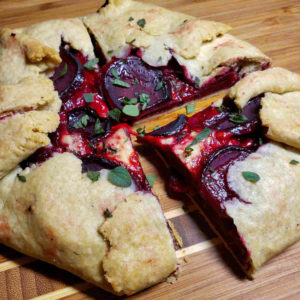
This final step is semi-optional. It has little effect on the flavor of the final dish, but it has a huge impact on the appearance. Without the egg wash, the crust wont brown as well and will have a dull appearance. With the egg wash, it browns better and will have that classic pie crust sheen. Transfer the baking sheet to the middle rack of an oven preheated to 425 degrees, and bake until the crust is fully cooked and well browned. Expect 35-45 minutes.

